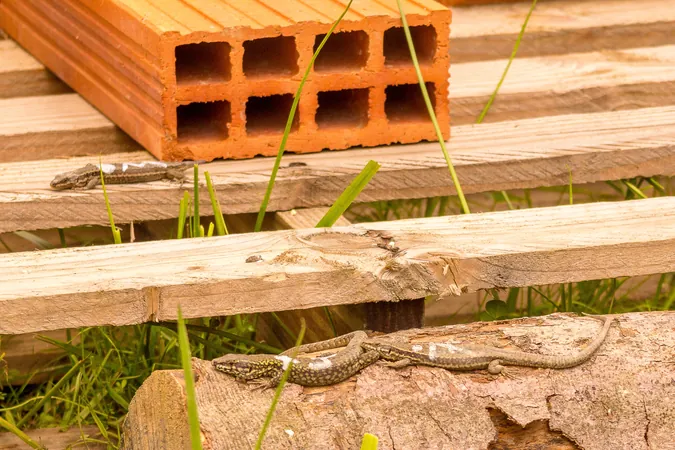
Wall Lizards Uncover Secrets of Territorial Warfare and Behavioral Mastery in Nature
2024-09-27
Wall Lizards Uncover Secrets of Territorial Warfare and Behavioral Mastery in Nature
In a groundbreaking study published in *Behavioral Ecology*, researchers have revealed that male wall lizards utilize complex behaviors to navigate territorial disputes, proving that actions speak louder than size or color.
Contrary to popular belief, darker male wall lizards, known for their aggressive tendencies, don't dictate their opponents’ responses. Instead, the study found that the lizards' actions—like hunching up to prepare for a fight or performing foot shakes to signal submission—are what truly influence the outcomes of confrontations.
Conducted by a team of international scientists from the University of Valencia in Spain, the Theoretical and Experimental Ecology Station (SETE) in France, and the University of Turku in Finland, the research examined the social behaviors of 180 common wall lizards (*Podarcis muralis*) within controlled enclosures specifically designed for these observations.
Javier Abalos from the University of Valencia sheds light on the phenomenon: “Aggressive encounters in nature rarely escalate to lethal fights. Instead, many species, including wall lizards, have evolved to use signals that allow them to convey their intentions without risking injury.” The team emphasized that understanding these behaviors can reshape our perception of animal interactions, particularly in territorial conflicts.
The study discovered that despite common expectations, aggression is not simply dictated by the size differences between competitors. Researchers Guillem Pérez i de Lanuza notes, “Often, weaker individuals continue to engage until they reach a self-imposed threshold, regardless of how mismatched they may be against their rivals.”
When it comes to signaling, the researchers found that certain physical characteristics like color can mark territory but do not always dictate aggression levels. Fixed traits like adult color patches may signal strength, but behaviors such as posturing are more dynamic and accurately depict an individual’s fighting intent.
Springtime in the Pyrenees triggers intense territorial battles among male wall lizards vying for the best basking spots and resources. Notably, males display a captivating array of behavior, including raised postures, throat extensions, and rapid limb movements, that help them communicate their intentions clearly.
In experimental settings, males exhibited a clear preference for high-quality sites, with 80% of females choosing these ideal locations. Males who established themselves in these areas not only won more confrontations but also had greater reproductive success by interacting with more females and siring more offspring.
The findings also highlight that while dark coloration may signal aggression, its impact on contest outcomes pales in comparison to behavioral displays. Interestingly, UV-blue markings on the lizards, thought to influence contests, showed negligible effects on their competitive success, turning the spotlight back on behavior as the main player in these interactions.
Researcher Alicia Bartolomé explains, “Our findings underline the significance of behavioral displays in territorial contests. Raised-body postures serve as effective threats, while foot shakes act as appeasement signals, allowing lizards to gauge whether to escalate a confrontation or back down.
This comprehensive study challenges long-held stereotypes about lizard behavior, suggesting they lead nuanced and complex social lives. The implications extend beyond wall lizards, reshaping our understanding of animal behavior across species.
The research team hopes to dispel misconceptions about lizards being simple creatures driven solely by instinct. Instead, they reveal a world where lizards utilize sophisticated social signals to navigate their interactions, highlighting Intelligence in the seemingly ruthless nature of these reptiles.
As scientists continue to unravel their social communication intricacies, it becomes increasingly evident that lizards are much more than just cold-blooded competitors in the wild; they are masterful strategists equipped with an impressive suite of behavioral tools that aid their survival and reproductive success.





 Brasil (PT)
Brasil (PT)
 Canada (EN)
Canada (EN)
 Chile (ES)
Chile (ES)
 España (ES)
España (ES)
 France (FR)
France (FR)
 Hong Kong (EN)
Hong Kong (EN)
 Italia (IT)
Italia (IT)
 日本 (JA)
日本 (JA)
 Magyarország (HU)
Magyarország (HU)
 Norge (NO)
Norge (NO)
 Polska (PL)
Polska (PL)
 Schweiz (DE)
Schweiz (DE)
 Singapore (EN)
Singapore (EN)
 Sverige (SV)
Sverige (SV)
 Suomi (FI)
Suomi (FI)
 Türkiye (TR)
Türkiye (TR)